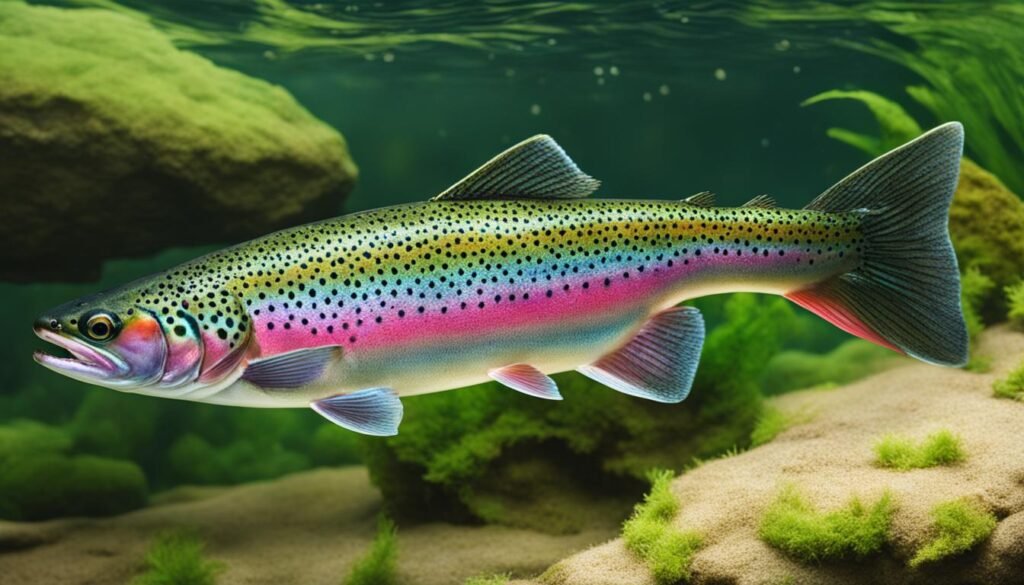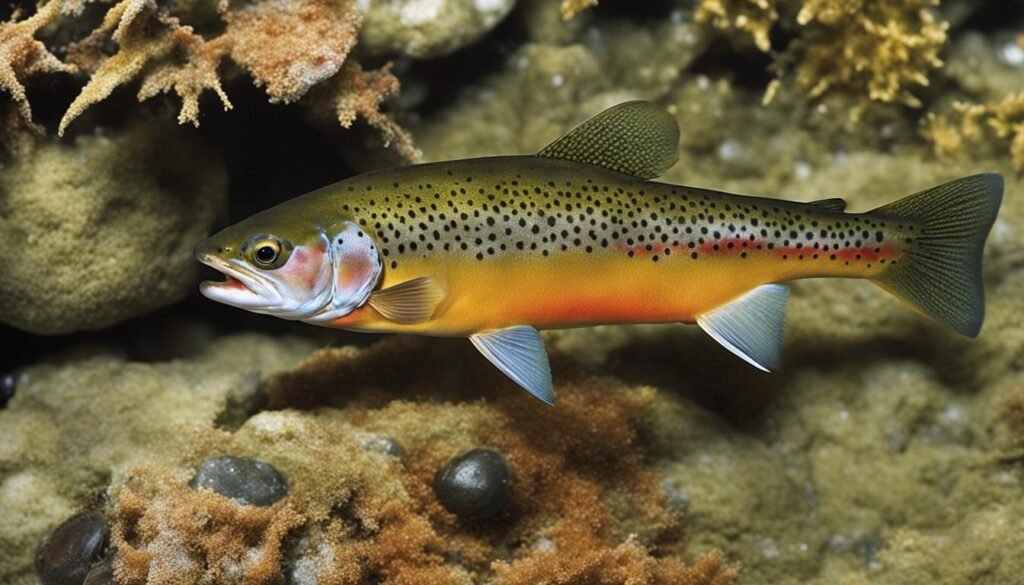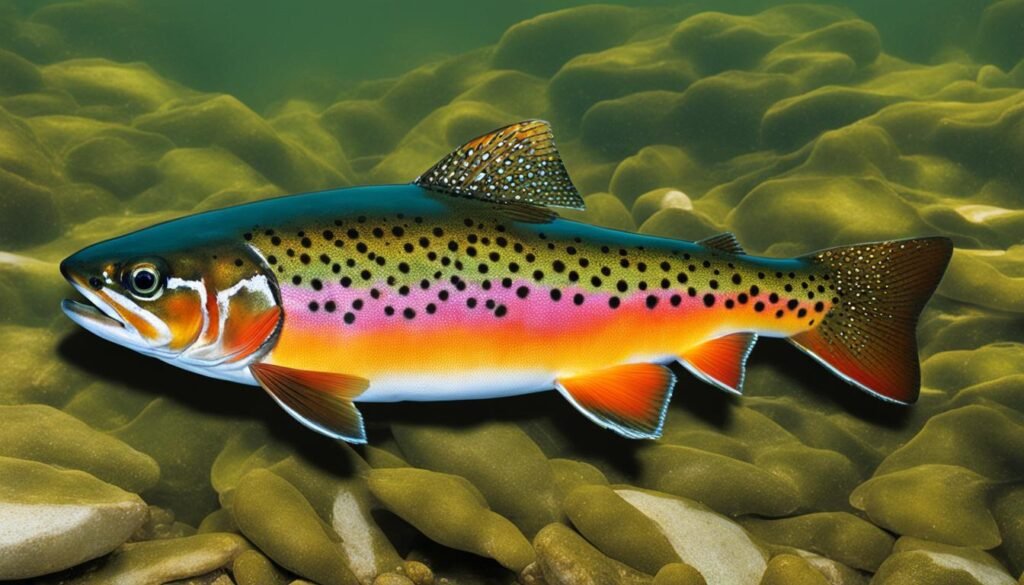When it comes to trout species, two names stand out: rainbow trout and cutthroat trout. While they may belong to the same family and genus, they have distinct characteristics that set them apart. Understanding these differences can enhance your fishing experience and appreciation for these fascinating fish.
Rainbow trout, scientifically known as Oncorhynchus mykiss, can be found from Russia to northern Mexico. They have a beautiful blue-green or olive-green coloration with black spots. One of their defining features is a broad reddish stripe that extends along their lateral line. On the other hand, cutthroat trout, classified as Oncorhynchus clarki, are native to the western United States and have a darker coloration with red or orange marks on their lower jaw.
These distinct appearances are just the beginning of the rainbow trout vs. cutthroat trout discussion. In this article, we will explore their respective characteristics, habitat preferences, and more, to give you a deeper understanding of these remarkable fish.
Key Takeaways:
- Rainbow trout and cutthroat trout have distinct differences in appearance and markings.
- Rainbow trout have a blue-green or olive-green coloration with black spots and a broad reddish stripe along their lateral line.
- Cutthroat trout have a darker coloration with red or orange marks on their lower jaw.
- Both species can be found in various habitats, but rainbow trout have a wider native range.
- Understanding these differences can enhance your fishing experience and appreciation for trout species.
Rainbow Trout Characteristics
Rainbow trout, scientifically known as Oncorhynchus mykiss, are native to a wide range of regions from Russia to northern Mexico. They typically have an overall blue-green or olive-green coloration with black spots covering their sides and back. Their distinguishing feature is the broad reddish stripe that extends along their lateral line from gills to tail, which gives them their popular name “rainbow” trout.

Rainbow trout can be found in various habitats, including streams, lakes, and rivers. They prefer cold, clear water with adequate oxygen levels. Some subspecies of rainbow trout, such as coastal rainbow trout and Columbia River redband trout, may also display red or pink throat markings similar to cutthroat trout.
Cutthroat Trout Characteristics

Cutthroat trout, scientifically known as Oncorhynchus clarki, are native to the western United States. They have a darker coloration compared to rainbow trout, ranging from golden to gray or green on the back. Cutthroat trout have distinctive red, pink, or orange marks on their lower jaw and in the folds of their gill plates, which gave them their common name. Their lower fins are typically yellowish to orange without any specific markings.
Cutthroat trout can be found in various habitats, including streams, rivers, and lakes. They have evolved into 14 distinct subspecies, each native to a different major drainage basin in the Rocky Mountains.
Differences in Appearance
Rainbow trout and cutthroat trout exhibit distinct differences in their appearance. Understanding these differences can help in identifying and appreciating the unique characteristics of each species.
Rainbow Trout Appearance
Rainbow trout, known scientifically as Oncorhynchus mykiss, have an overall blue-green or olive-green coloration with black spots covering their sides and back. These spots are often more concentrated towards the tail. However, the defining feature of rainbow trout is the broad reddish stripe that extends along their lateral line from the gills to the tail. This vibrant stripe is what gives them their popular name “rainbow” trout.

Cutthroat Trout Appearance
Cutthroat trout, scientifically classified as Oncorhynchus clarki, have a darker coloration compared to rainbow trout. Their back ranges from golden to gray or green, providing effective camouflage in their natural habitat. One of the most distinctive markings of cutthroat trout is the presence of red, pink, or orange marks on their lower jaw. These marks also extend to the folds of their gill plates, creating a striking visual contrast. Cutthroat trout’s lower fins are typically yellowish to orange without any specific markings.
While both rainbow trout and cutthroat trout can display similar red or pink markings on their throat, cutthroat trout have additional distinguishing features. They have a set of basibranchial teeth at the base of their tongue and a maxillary that extends beyond the posterior edge of the eye.

These distinct appearances make rainbow trout and cutthroat trout easily recognizable to anglers and nature enthusiasts alike. Whether admiring their vibrant rainbow stripe or observing the striking red markings on their lower jaw, each trout species showcases its unique beauty and adds to the diversity of our aquatic ecosystems.
Habitat Preferences
In order to understand the habitat preferences of rainbow trout and cutthroat trout, it is important to consider their respective ranges and natural habitats.
Rainbow Trout Habitat and Range
Rainbow trout, Oncorhynchus mykiss, have a wide native range that extends from Russia to northern Mexico. They are commonly found in various regions, including:
- Kamchatka Peninsula
- Alaska
- The Cascade and Rocky Mountains
- Eastern streams throughout the Appalachian Mountains
Rainbow trout have adapted to different habitats and can be found in streams, lakes, and rivers. They prefer cold, clear water with adequate oxygen levels.
Cutthroat Trout Habitat and Range
Cutthroat trout, Oncorhynchus clarki, are native to the western United States. They have evolved into 14 distinct subspecies, each native to a different major drainage basin in the Rocky Mountains. Cutthroat trout can be found in:
- Streams
- Rivers
- Lakes
Unlike rainbow trout, cutthroat trout have a more specific range that extends to the Rocky Mountains. They prefer cooler water temperatures.

Both rainbow trout and cutthroat trout have unique habitat preferences that enable them to thrive in their respective ranges. Understanding these preferences can be valuable for anglers and conservationists in ensuring the preservation and conservation of these beautiful fish species.
Interbreeding and Hybridization
While rainbow trout and cutthroat trout are different species, they possess a unique ability to interbreed, leading to fascinating hybrid offspring known as “cutbow” trout. In areas where the ranges of rainbow trout and cutthroat trout overlap, these populations of cutbow trout can be found.

Cutbow Trout Characteristics
Cutbow trout are a fascinating hybrid species that result from the interbreeding of rainbow trout and cutthroat trout. As a result, they often exhibit characteristics of both parent species, making them unique and sought after by anglers and nature enthusiasts.
One of the distinguishing features of cutbow trout is their appearance, which combines elements from both rainbow and cutthroat trout. Like rainbow trout, they can have a broad, reddish stripe that extends along their lateral line, adding a splash of vibrant color to their overall appearance. At the same time, cutbow trout may also display the striking red or pink markings on their lower jaws and gill plates that are characteristic of cutthroat trout.
This image showcases the unique beauty of the cutbow trout, highlighting its blended characteristics and distinct markings. With the combination of the rainbow trout’s colorful stripe and the cutthroat trout’s vibrant red or pink markings, the cutbow trout stands out as a visually captivating fish.
Identifying a cutbow trout can be somewhat challenging for anglers who are not familiar with the species, as they exhibit a mix of features from both rainbow and cutthroat trout. However, this blend only adds to their allure, making them a thrilling catch for those who can appreciate their exceptional characteristics.
| Characteristic | Appearance |
|---|---|
| Broad Stripe | Similar to Rainbow Trout |
| Red or Pink Markings | Similar to Cutthroat Trout |
As shown in the table above, cutbow trout exhibit a combination of characteristics from both parent species, creating a visually stunning fish with a distinctive appearance.
“Cutbow trout are a testament to the fascinating world of hybridization and the incredible diversity it can lead to in nature. Their blended characteristics make them a true gem among trout species.”
In conclusion, cutbow trout are an extraordinary hybrid species that showcase the beauty and diversity of nature. With their unique blend of traits from rainbow and cutthroat trout, they captivate both anglers and nature enthusiasts alike. Whether it’s their broad reddish stripe or their eye-catching red or pink markings, cutbow trout are an exceptional addition to any fishing experience.
Taxonomy of Rainbow Trout and Cutthroat Trout
Rainbow trout and cutthroat trout belong to the same family, Salmonidae, but they are classified under different genera and species. Rainbow trout are classified as Oncorhynchus mykiss, while cutthroat trout are classified as Oncorhynchus clarki. The taxonomy of these trout species helps to differentiate them and understand their evolutionary relationships.

| Classification | Rainbow Trout | Cutthroat Trout |
|---|---|---|
| Family | Salmonidae | Salmonidae |
| Genus | Oncorhynchus | Oncorhynchus |
| Species | mykiss | clarki |
The classification of rainbow trout as Oncorhynchus mykiss and cutthroat trout as Oncorhynchus clarki provides a scientific framework for understanding the unique characteristics and evolutionary history of these trout species.
Identifying Different Trout Species
Different trout species can be easily identified based on their unique characteristics, coloration, and markings. To help you distinguish between the various trout species, here are some key points to look for:
1. Brook Trout
Brook trout, also known as Salvelinus fontinalis, have a distinct appearance that sets them apart from other trout species. They typically have dark green to brown backs with lighter mottled sides. One of their most defining features is the presence of red spots encircled by a bluish halo. These beautiful fish can be found in freshwater streams and lakes across North America.
2. Brown Trout
Brown trout, scientifically known as Salmo trutta, are known for their dark brown back and sides. Unlike brook trout, brown trout have larger black spots that are often accompanied by red or orange spots encased in lighter halos. They are popular among anglers for their challenging nature and can be found in both freshwater and saltwater environments.
3. Rainbow Trout
Rainbow trout, scientifically named Oncorhynchus mykiss, are easily recognizable due to their prominent colors. They have a broad reddish-pink stripe running along their sides, which gives them their name. Rainbow trout also have small black spots scattered across their body and a whitish belly. These trout are widely distributed and can be found in freshwater habitats around the world. They are popular targets for fishing enthusiasts.
4. Cutthroat Trout
Cutthroat trout, classified as Oncorhynchus clarki, display unique markings that help in their identification. They have red or orange marks on their lower jaw and in the folds of their gill plates, which distinguish them from other trout species. Cutthroat trout are predominantly found in freshwater streams and lakes in the western United States.
5. Marble Trout
Marble trout, or Salmo marmoratus, have a distinct marbled pattern across their body, which makes them easy to identify. Their coloration varies from light to dark brown, and they often have spots or blotches spread across their back. Marble trout are native to rivers and lakes in parts of Europe, including the Adriatic Sea basin.
By recognizing these unique characteristics and features, you can confidently identify different trout species during your fishing or outdoor adventures.

| Trout Species | Characteristics |
|---|---|
| Brook Trout | Dark green to brown back Lighter mottled sides Red spots encircled by a bluish halo |
| Brown Trout | Dark brown back Larger black spots Red or orange spots encased in lighter halos |
| Rainbow Trout | Broad reddish-pink stripe along sides Small black spots Whitish belly |
| Cutthroat Trout | Red or orange marks on lower jaw and gill plates |
| Marble Trout | Marbled pattern across body Varying shades of light to dark brown Spots or blotches on back |
Differences in Fin Types
When identifying different trout species, one important characteristic to consider is their fin types. The fins of trout can provide valuable clues to help distinguish between species. Let’s take a closer look at the fin types of some common trout species:
Brook Trout Fins
Brook trout, also known as Salvelinus fontinalis, have distinct fin colors and patterns that make them easily recognizable. Their lower fins have a white leading edge followed by a black stripe, creating a striking contrast against their vibrant reddish-orange color. This unique combination of colors in the fins is a key characteristic of brook trout.
Brown Trout Fins
Brown trout, scientifically referred to as Salmo trutta, have a different fin appearance compared to brook trout. Their lower fins lack the distinctive color contrasts seen in brook trout. Instead, brown trout have fins that are consistent in coloration, often matching the overall color of their body.
Rainbow Trout Fins
Rainbow trout, known as Oncorhynchus mykiss, exhibit an interesting fin pattern that sets them apart from other trout species. They have small black spots that extend onto their dorsal and adipose fins, creating a speckled appearance. This distinctive feature can help identify rainbow trout in various fishing scenarios.
Cutthroat Trout Fins
Cutthroat trout, scientifically classified as Oncorhynchus clarkii, have lower fins that are typically yellowish to orange in color without any specific markings. Unlike rainbow trout, cutthroat trout generally lack distinct black spots on their fins. This fin characteristic is a prominent clue in distinguishing cutthroat trout from other species.
Marble Trout Fins
Marble trout, with the scientific name Salmo marmoratus, have fins that match the color of their body, without any distinct markings. The subtle and uniform coloration of marble trout fins is unique among trout species and can aid in their identification.
In summary, observing the fin types of trout species can provide valuable insights and help differentiate between them. Whether it’s the vibrant colors and patterns of brook trout, the uniform coloration of brown trout fins, the speckled appearance of rainbow trout, the yellowish to orange lower fins of cutthroat trout, or the matching coloration of marble trout fins, paying attention to these details can enhance the experience of identifying and appreciating the diversity of trout species.
Conclusion
Rainbow trout and cutthroat trout are both fascinating members of the trout family, but they have distinct differences that set them apart. While rainbow trout have a beautiful blue-green or olive-green coloration with black spots and a vibrant reddish stripe along their lateral line, cutthroat trout sport a darker hue with striking red or orange marks on their lower jaw. These differences in appearance make it easy to identify each species while out on the water.
Not only do rainbow trout and cutthroat trout differ in their coloration, but they also have different habitat preferences. Rainbow trout can be found in a wide range of habitats, from streams and rivers to lakes, while cutthroat trout are native to the western United States. Their habitat preferences and ranges offer anglers and nature enthusiasts the opportunity to seek out different environments when pursuing these beautiful fish.
Additionally, it’s interesting to note that rainbow trout and cutthroat trout can interbreed, resulting in hybrid offspring known as cutbow trout. These unique fish exhibit a mix of characteristics from both parent species, making them a special find for anglers. Understanding these key differences between rainbow trout and cutthroat trout can enhance the experience of those who appreciate the diversity of trout species and provide a deeper understanding of the natural world.
FAQ
What are the key differences between rainbow trout and cutthroat trout?
Rainbow trout and cutthroat trout have distinct differences in appearance and markings. Rainbow trout have an overall blue-green or olive-green coloration with black spots and a broad reddish stripe along their lateral line, while cutthroat trout have a darker coloration with red or orange marks on their lower jaw.
Where are rainbow trout native to?
Rainbow trout are native to a wide range of regions from Russia to northern Mexico. They can be found in various habitats, including streams, lakes, and rivers.
Where are cutthroat trout native to?
Cutthroat trout are native to the western United States, with their range extending to the Rocky Mountains. They can be found in streams, rivers, and lakes.
Can rainbow trout and cutthroat trout interbreed?
Yes, rainbow trout and cutthroat trout can interbreed. In areas where their ranges overlap, hybrid offspring known as “cutbow” trout can be found.
How can cutbow trout be identified?
Cutbow trout are a hybrid species resulting from the interbreeding of rainbow trout and cutthroat trout. They often display characteristics of both parent species, such as the broad reddish stripe along their lateral line like rainbow trout and the red or pink markings on their lower jaws and gill plates like cutthroat trout.
How can different trout species be identified?
Different trout species can be identified by their unique characteristics, coloration, and markings. For example, brook trout have dark green to brown backs, lighter mottled sides, and red spots encircled by a bluish halo. Brown trout have a dark brown back, larger black spots, and red or orange spots encased in lighter halos. Rainbow trout have a broad reddish-pink stripe along their sides, small black spots, and a whitish belly. Cutthroat trout have red or orange marks on their lower jaw and in the folds of their gill plates. Marble trout have a marbled pattern across their body. Fin types can also help in identifying different trout species.
What are the differences in fin types among trout species?
Brook trout have lower fins with a white leading edge followed by a black stripe and a vibrant reddish-orange color. Brown trout lack the distinctive color contrasts in their lower fins seen in brook trout. Rainbow trout have small black spots that extend onto their dorsal and adipose fins, while cutthroat trout have yellowish to orange lower fins without any specific markings. Marble trout have lower fins that match the belly color, without any distinct markings.

